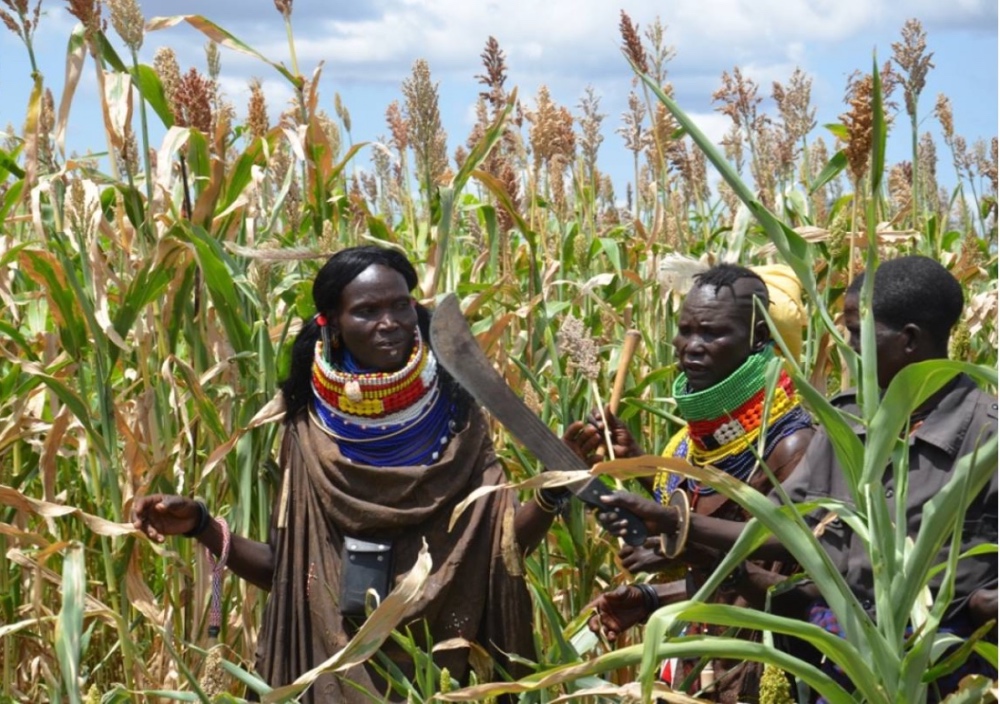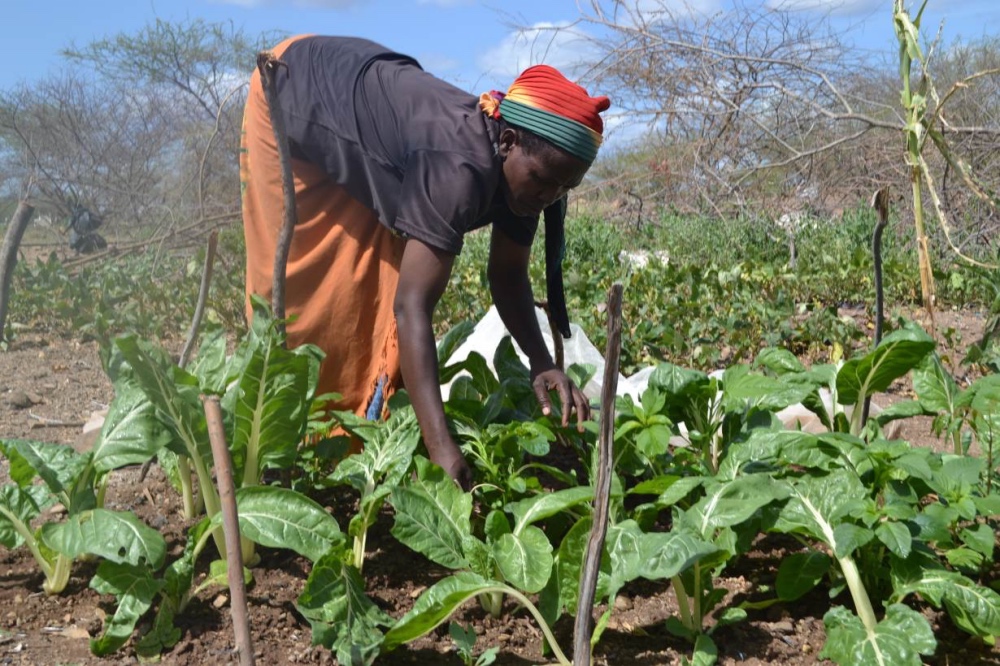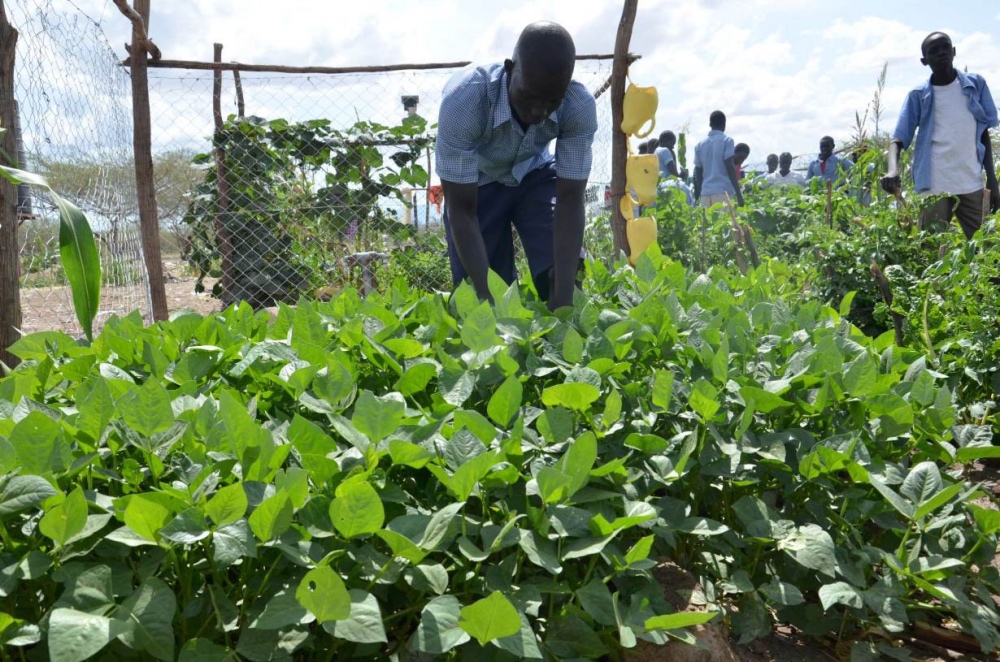
ISAIAH ESIPISU, writing for the Thomson Reuters Foundation, reports on 14 year project that aims to provide refugees with sustainable livelihoods through agriculture, while helping them integrate with the local Kenyan community…
Turkana, Kenya
Thomson Reuters Foundation
Kenyan villager Ekeno Pedo never considered that golden fields of sorghum – or indeed any crop – might one day flourish on the outskirts of his village in drought-stricken Turkana county.
“From the time I was a small herdsboy in this community I never imagined the possibility of farming in this area given the tough climate and our nomadic lifestyle,” said 65-year-old Pedo.

Nomadic pastoralists tend to sorghum crops in fields that are shared with refugees in Kalobeyei camp in Turkana County, Kenya, in June. PICTURE: Isaiah Esipisu/Thomson Reuters Foundation
The fields that have sprung up in this vast and arid scrubland in Kenya’s northwest are in part due to the hard work of refugees, who have come here from neighbouring South Sudan, Ethiopia and Uganda in recent decades.
Turkana is Kenya’s second largest county and its poorest, yet in 2015 it donated 1,500 hectares of land for the refugee settlement of about 60,000 people near Pedo’s village of Kalobeyei.
“Apart from seeing our people marry some of the refugees, they also guide us a lot when it comes to farming, because some of them came from communities that depended on agriculture.”
– Jeremiah Kazimoto, a nomadic pastoralist.
The idea was to develop an agricultural project that would help bring together the new arrivals and locals.
Residents and refugees alike say it has worked well.
“Apart from seeing our people marry some of the refugees, they also guide us a lot when it comes to farming, because some of them came from communities that depended on agriculture,” said 50-year-old nomadic pastoralist, Jeremiah Kazimoto.
Namuzungu Berta, a refugee from the Democratic Republic of Congo, said it was liberating for refugees to grow their own food and earn an income, instead of relying on aid.
“With this arrangement, we now have the freedom to choose what to eat, because we can either grow it or buy from the community,” said Berta.
The project began as kitchen gardens in 2016, but today it includes 100 hectares of sorghum, a cereal, with large fields subdivided between refugees and the local community, which both harvest and earn money from the crop.
When the sorghum ripens, the farmers sell it to aid agencies, which grind it and use it to feed the refugees.
“I harvested seven bags of sorghum from my quarter-hectare piece of land, and I sold four of them to the Red Cross at a premium price of 3,000 Kenyan shillings ($US30) for a 50 kilogram bag,” said Jackson Akure Sokona, a resident from nearby Kolioro village.
The kitchen gardens and the more recent sorghum crop were part of a €15 million development project for the area funded by the European Union Emergency Trust Fund for Africa, and implemented by the local authorities and the United Nation’s Food and Agriculture Organization.
The 14 year project, which ends in 2030, aims to provide refugees with sustainable livelihoods through agriculture, while helping them integrate with their host community. It is the first of its kind in Kenya, UN officials said.

A refugee from Burundi tends to her kitchen garden in Kalobeyei camp in Turkana County, Kenya. PICTURE: Isaiah Esipisu/Thomson Reuters Foundation
“Due to prolonged political instability in some neighbouring countries, refugees are almost permanent here. So it makes sense to allow them to generate an income alongside the host community,” said Gabriel Rugalema from the FAO in Kenya.
“When you allow them to mingle and work together, they get used to each other,” he told the Thomson Reuters Foundation.
Kenya continues to experience an influx of refugees, the FAO said, which reinforces the need to help them become economically self-sufficient and less dependent on aid.
Local authorities say they also hope to avoid complications encountered in 2015 at Kakuma camp, some 40 kilometres away, where the host community felt they did not benefit from the refugees’ presence.
The goal at Kalobeyei is for the local community of about 20,000 people to take over the refugees’ small-scale farms if and when they go home, allowing the area to remain productive.
“Food security is one of our priorities, and if the refugees can work alongside our communities to produce food locally, then we must support such an initiative.”
– Peter Emuria Lotethiro, deputy governor of Turkana.
“Food security is one of our priorities, and if the refugees can work alongside our communities to produce food locally, then we must support such an initiative,” Turkana Deputy Governor Peter Emuria Lotethiro told the Thomson Reuters Foundation.
Turkana’s low rainfall makes farming here challenging. The area is sorely in need of rainwater harvesting techniques such as sand dams and underground water tanks.
In addition, its soils and water are saline and struggle to support agriculture, which is why most local people keep livestock – mainly sheep and goats.
But technologies like sunken-bed farming and irrigation have enabled them to use stored rainwater to cultivate crops.
“We are using proven rainwater harvesting techniques to capitalise on perennial floods in this area whenever it rains,” said Zippy Mbati, a programme officer at the World Food Programme.

Students tend to their kitchen gardens at Kalobeyei Settlement School, in Kalobeyei camp in Turkana County, Kenya. PICTURE: Isaiah Esipisu/Thomson Reuters Foundation
Community members who take part in the farming project are trained to plant sorghum using a method in which a sand barrier is built in front of the growing area, capturing rainwater and releasing it slowly, the FAO said.
Work is underway to expand the area under cultivation: the Turkana government and the FAO are due to set up an irrigation system on a 400 hectare piece of land set aside for farming in Kalobeyei, said FAO field officer Michael Ngututo.
This will give 3,500 people enough land to produce about 100 metric tonnes of food worth 100 million Kenyan shillings ($US996,000), Ngututo said.
Meantime, refugees who have made this arid part of Kenya home said they were glad of the difference the project has made to their lives.
“As a refugee, it is very exciting that I am able to grow and feed my children on fresh vegetables,” said Hellen Chebachoge, who was relocated here from Dadaab refugee camp in northeast Kenya earlier this year.
“I came from a farming community in Uganda, and so having a kitchen garden makes me feel at home.”





